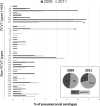Bacterial Density, Serotype Distribution and Antibiotic Resistance of Pneumococcal Strains from the Nasopharynx of Peruvian Children Before and After Pneumococcal Conjugate Vaccine 7
- PMID: 26974749
- PMCID: PMC4820239
- DOI: 10.1097/INF.0000000000001030
Bacterial Density, Serotype Distribution and Antibiotic Resistance of Pneumococcal Strains from the Nasopharynx of Peruvian Children Before and After Pneumococcal Conjugate Vaccine 7
Abstract
Background: Pneumococcal conjugate vaccines (PCV) have decreased nasopharyngeal carriage of vaccine types but little data exist from rural areas. We investigated bacterial density, serotype distribution and antibiotic resistance of pneumococcal strains within the nasopharynx of young children in the Peruvian Andes, 2 years after PCV7 was introduced.
Methods: Pneumococcal strains were isolated from a subset of 125 children from our Peruvian cohort, who entered the study in 2009 and had pneumococcus detected in the nasopharynx in both 2009 and during follow-up in 2011. Strains were Quellung serotyped and tested for susceptibility to antibiotics. Bacterial density was determined by quantitative polymerase chain reaction.
Results: The prevalence of PCV7 strains decreased from 48% in 2009 to 28.8% in 2011, whereas non-PCV7 types increased from 52% to 71.2% (P = 0.002). There was a 3.5-fold increase in carriage of serotype 6C in 2011 (P = 0.026). Vaccination with PCV7 did not affect pneumococcal density in children colonized by a PCV7 type but did increase density in those colonized with a non-PCV7 type. Antibiotic resistance did not change after vaccine introduction; strains were nonsusceptible to tetracycline (97.2%), trimethoprim-sulfamethoxazole (56.4%), penicillin (34%), erythromycin (22.4%), chloramphenicol (18.8%) and clindamycin (12.4%).
Conclusions: Serotype replacement was observed post-PCV7 vaccination with a concomitant, not previously recognized, increased nasopharyngeal density.
Figures



Similar articles
-
Changes in Streptococcus pneumoniae serotype distribution in invasive disease and nasopharyngeal carriage after the heptavalent pneumococcal conjugate vaccine introduction in Bogotá, Colombia.Vaccine. 2013 Aug 20;31(37):4033-8. doi: 10.1016/j.vaccine.2013.04.074. Epub 2013 May 14. Vaccine. 2013. PMID: 23680440
-
Emerging Streptococcus pneumoniae Strains Colonizing the Nasopharynx in Children After 13-valent Pneumococcal Conjugate Vaccination in Comparison to the 7-valent Era, 2006-2015.Pediatr Infect Dis J. 2016 Aug;35(8):901-6. doi: 10.1097/INF.0000000000001206. Pediatr Infect Dis J. 2016. PMID: 27420806 Free PMC article.
-
Impact of PCV7 vaccination on nasopharyngeal carriage and antimicrobial resistance among children in Turkey.J Infect Dev Ctries. 2019 Mar 31;13(3):227-232. doi: 10.3855/jidc.10833. J Infect Dev Ctries. 2019. PMID: 32040452
-
Impact of pneumococcal conjugate vaccine on infections caused by antibiotic-resistant Streptococcus pneumoniae.Clin Microbiol Infect. 2009 Apr;15 Suppl 3:16-20. doi: 10.1111/j.1469-0691.2009.02726.x. Clin Microbiol Infect. 2009. PMID: 19366365 Review.
-
[Serotype diversity and antimicrobial resistance of Streptococcus pneumoniae].Vestn Ross Akad Med Nauk. 2014;(7-8):38-45. doi: 10.15690/vramn.v69i7-8.1108. Vestn Ross Akad Med Nauk. 2014. PMID: 25563003 Review. Russian.
Cited by
-
Increase of Macrolide-Resistance in Streptococcus pneumoniae Strains After the Introduction of the 13-Valent Pneumococcal Conjugate Vaccine in Lima, Peru.Front Cell Infect Microbiol. 2022 May 9;12:866186. doi: 10.3389/fcimb.2022.866186. eCollection 2022. Front Cell Infect Microbiol. 2022. PMID: 35615398 Free PMC article.
-
Nasopharyngeal Pneumococcal Density and Evolution of Acute Respiratory Illnesses in Young Children, Peru, 2009-2011.Emerg Infect Dis. 2016 Nov;22(11):1996-1999. doi: 10.3201/eid2211.160902. Emerg Infect Dis. 2016. PMID: 27767919 Free PMC article.
-
Development of a TaqMan Array Card for Pneumococcal Serotyping on Isolates and Nasopharyngeal Samples.J Clin Microbiol. 2016 Jul;54(7):1842-1850. doi: 10.1128/JCM.00613-16. Epub 2016 May 11. J Clin Microbiol. 2016. PMID: 27170020 Free PMC article.
-
Dynamics of Bacterial Colonization With Streptococcus pneumoniae, Haemophilus influenzae, and Moraxella catarrhalis During Symptomatic and Asymptomatic Viral Upper Respiratory Tract Infection.Clin Infect Dis. 2018 Mar 19;66(7):1045-1053. doi: 10.1093/cid/cix941. Clin Infect Dis. 2018. PMID: 29121208 Free PMC article.
-
Early Declines in Vaccine Type Pneumococcal Carriage in Children Less Than 5 Years Old After Introduction of 10-valent Pneumococcal Conjugate Vaccine in Mozambique.Pediatr Infect Dis J. 2018 Oct;37(10):1054-1060. doi: 10.1097/INF.0000000000002134. Pediatr Infect Dis J. 2018. PMID: 30216295 Free PMC article.
References
-
- Mulholland K. Childhood pneumonia mortality--a permanent global emergency. Lancet. 2007;370:285–289. - PubMed
-
- O'Brien KL, Wolfson LJ, Watt JP, et al. Burden of disease caused by Streptococcus pneumoniae in children younger than 5 years: global estimates. Lancet. 2009;374:893–902. - PubMed
-
- Bryce J, Boschi-Pinto C, Shibuya K, Black RE. WHO estimates of the causes of death in children. Lancet. 2005;365:1147–1152. - PubMed
-
- Wardlaw T, Salama P, Johansson EW, Mason E. Pneumonia: the leading killer of children. Lancet. 2006;368:1048–1050. - PubMed
-
- Bogaert D, De Groot R, Hermans PW. Streptococcus pneumoniae colonisation: the key to pneumococcal disease. The Lancet infectious diseases. 2004;4:144–154. - PubMed
Publication types
MeSH terms
Substances
Grants and funding
LinkOut - more resources
Full Text Sources
Other Literature Sources
Medical
Molecular Biology Databases

